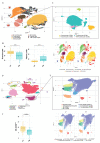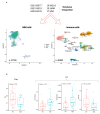Ferritin Metabolism Reflects Multiple Myeloma Microenvironment and Predicts Patient Outcome
- PMID: 37240197
- PMCID: PMC10218632
- DOI: 10.3390/ijms24108852
Ferritin Metabolism Reflects Multiple Myeloma Microenvironment and Predicts Patient Outcome
Abstract
Multiple myeloma (MM) is a hematologic malignancy with a multistep evolutionary pattern, in which the pro-inflammatory and immunosuppressive microenvironment and genomic instability drive tumor evolution. MM microenvironment is rich in iron, released by pro-inflammatory cells from ferritin macromolecules, which contributes to ROS production and cellular damage. In this study, we showed that ferritin increases from indolent to active gammopathies and that patients with low serum ferritin had longer first line PFS (42.6 vs. 20.7 months and, p = 0.047, respectively) and OS (NR vs. 75.1 months and p = 0.029, respectively). Moreover, ferritin levels correlated with systemic inflammation markers and with the presence of a specific bone marrow cell microenvironment (including increased MM cell infiltration). Finally, we verified by bioinformatic approaches in large transcriptomic and single cell datasets that a gene expression signature associated with ferritin biosynthesis correlated with worse outcome, MM cell proliferation, and specific immune cell profiles. Overall, we provide evidence of the role of ferritin as a predictive/prognostic factor in MM, setting the stage for future translational studies investigating ferritin and iron chelation as new targets for improving MM patient outcome.
Keywords: bone marrow microenvironment; ferritin; monoclonal gammopathy of undetermined significance; multiple myeloma; smoldering myeloma.
Conflict of interest statement
The authors declare no conflict of interest.
Figures




References
-
- Plano F., Corsale A.M., Gigliotta E., Camarda G., Vullo C., Di Simone M., Shekarkar Azgomi M., Speciale M., Carlisi M., Caccamo N., et al. Monoclonal Gammopathies and the Bone Marrow Microenvironment: From Bench to Bedside and Then Back Again. Hematol. Rep. 2023;15:23–49. doi: 10.3390/hematolrep15010004. - DOI - PMC - PubMed
-
- Cucè M., Gallo M.E., Siciliano Cantafio M.A., Riillo C., Caracciolo D., Scionti F., Staropoli N., Zuccalà V., Maltese L., Di Vito A., et al. Trabectedin triggers direct and NK-mediated cytotoxicity in multiple myeloma. J. Hematol. Oncol. 2019;12:32. doi: 10.1186/s13045-019-0714-9. - DOI - PMC - PubMed
MeSH terms
Substances
Grants and funding
LinkOut - more resources
Full Text Sources
Medical

